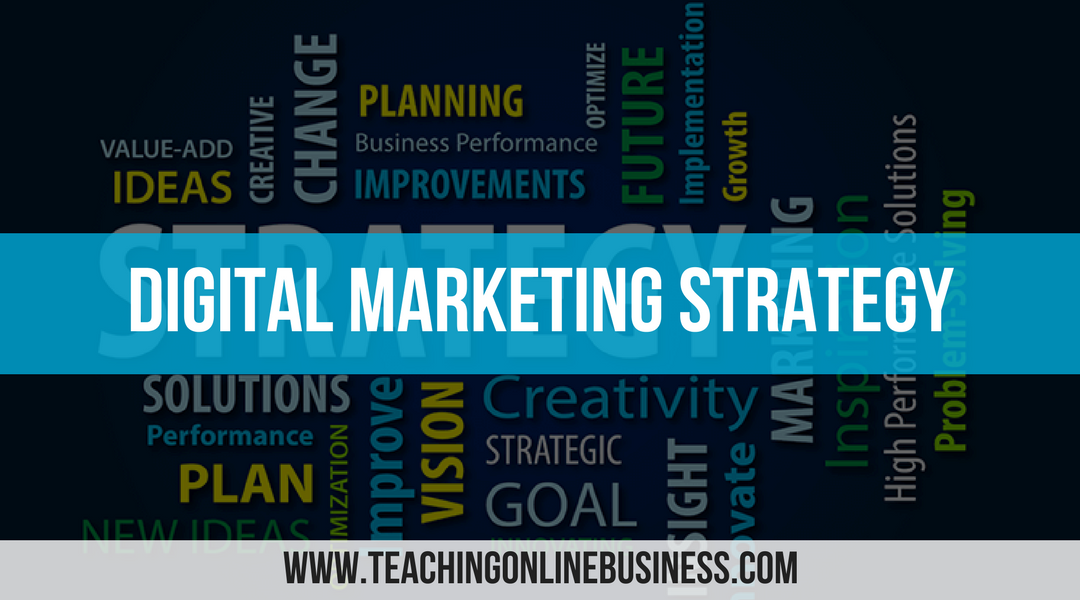In today’s competitive business environment, a big part of your marketing strategy (if not ALL) needs to be digital. Where’s your clients today? Your targeted clients are online using the internet and if you don’t have a digital marketing strategy in place to reach them, you won’t be able to take advantage of this huge market.
The business landscape is always changing and you must be willing to adapt quickly as the online markets change quicker than ever before. It’s ground zero and you need a digital marketing strategy for your business. To help you fully understand what you need to focus on with your marketing strategies, we’ve compiled a list of 5 areas to get your strategy dialed in.
What Is A Digital Marketing Strategy?
Quickest definition: Your digital marketing strategy is a series of steps you’ll be taking with your online marketing to achieve the goals you’ve outlined for your business. A lot of business owners and entrepreneurs get overwhelmed thinking about their online marketing strategy. Your digital strategy doesn’t have to be difficult, I’ll give you a better way to look at it.
Having the ability to generate new leads is a common marketing strategy many businesses have. You may have a goal of collecting 100 new leads a month. How you plan to do that would be a part of your digital marketing strategy. Your strategy can have multiple goals and strategies, most online marketing strategies do.
Your digital marketing strategy is going to reflect all the different strategies you plan on using while referencing all the different goals those strategies will be achieving.
Your Digital Marketing Campaigns
Another common misconception that businesses have is that a digital marketing strategy and digital marketing campaign is the same thing. That’s not true.
As we outlined above, a digital marketing strategy is a series of steps you’ll take to achieve your business goals. A digital marketing campaign builds the foundation and building blocks of your digital marketing strategy by outlining the actions you’ll be taking to achieve your goals.
For example, you may run a digital marketing campaign using Facebook ads to generate new leads for your business. This marketing campaign would be a part of your overall digital strategy. Digital marketing campaigns can run for a few days, weeks, months or even years. Even so, this campaign doesn’t become a strategy, it remains a digital marketing campaign and nothing more.
Now that you know the difference between digital marketing strategies and digital marketing campaigns, let’s start building your strategy.
(1) Who’s Your Perfect Customer/Clients
The very first step to building your digital marketing strategy is knowing exactly who you’ll be marketing too. This is why we create customer profiles. Every business needs customer profiles. It helps you identify who your target audience is. Also called buyer personas or buyer profiles, customer profiles help you identify who your perfect customers are.
Creating customer profiles is simple. You can create them by doing your research. We call this customer research. What we want to do is identify what makes are perfect customers unique. The best way to do this is by getting feedback from your audience. You can get valuable data by doing reviews, surveys, interviews and research.
There’s a lot of data points you can collect on your ideal customers. To give you an idea of what makes up a customer profile, we built a list you can use below.
- Age – What age range does your ideal customers fall in?
- Gender – Is your target customers male, female or both?
- Location – Where do your perfect customers live?
- Income – How much money does your ideal customers make?
- Job Title – What job titles does your target audience have?
- Goals – What goals do your perfect customers have?
- Challenges – What are the challenges your ideal audience deal with?
- Priorities – What are the main priorities of your target
(2) What’s Your Marketing Goals
Your marketing goals should always integrate with your business goals. Your business likely has goals and milestones you want to hit. You’ll use your marketing strategy and campaigns to accomplish your marketing goals. For example, if you want to increase revenue by 50 percent, your goal may be to generate 100 percent more leads to contribute to hitting that revenue goal.
While you establish your digital marketing goals, it’s vital that you have the ability to track and measure the outcome of your digital marketing campaigns. Here’s some of the tools I use to measure the results of my digital marketing campaigns.
- ClickFunnels – ClickFunnels is a vital tool in my business. It allows me to easily build funnels for my business such as sales funnels, lead funnels and influencer funnels. With CF, I’m able to track important data points such as optin rates, landing page conversion rates, sales conversions. Every business needs funnels, ClickFunnels is the best tool to make your funnels.
- Active Campaign – Email software, it’s vital to every business. You’ve heard it before, “your money is in the list.” That’s true. If you’re not collecting leads, you’re leaving sales on the table. You need the ability to generate leads, segment leads and provide follow ups to your leads. AC is the email tool I use in my business and the one I recommend to you.
- Google Analytics – Google Analytics is a must-have tool that allows you to track everything you need to track. Not only does it give you analytics for all the pages on your website, it also allows you to track conversions and sales.
(3) Analyzing Your Digital Assets, Vehicles And Channels
It’s easy to get overwhelmed thinking about all the different platforms and channels you could be promoting on. Don’t let it get the best of you, let’s take it a step at a time. First, we’ll cover the digital assets you have own. This would include;
Online Assets You Own
- Blog
- Website
- Social Media Profiles
- Videos
- Images
- Groups/Forums/Communities
Paid Online Assets
- Native Advertising – This refers to native ads on other websites
- Google AdWords – Google’s paid advertising platform
- Facebook/Instagram Ads – Facebook’s paid advertising platform
- Social Media Ads – Twitter, LinkedIn, ect.
- AdRoll – A popular advertising platform
Other Online Assets
- Influencer Marketing
- PR
- Networks
- Current Customers
- Communities You Don’t Own
There’s many things listed above that will be a part of your digital marketing strategy. You need to create a spreadsheet or document so you can see every asset and vehicle at once. What roles will they play as you begin to build your digital marketing strategy. Make sure you include everything.
Competitor Research
There’s a lot of data and insights you can collect by researching your top competitors. I use an awesome tool called Ahrefs to perform competitor research. Although this tool is often labeled as a SEO tool, it’s much more than that.
With Ahrefs, I can identify what my competitors are doing to improve their organic traffic. I can see the keywords they target, I can see their backlink profile and I can break down the exact anchor text any ranking page has. I can also identify what they’re using for paid ads within Google. I can see the exact keywords my competitors are paying for.
Thanks to Built With, I can see the exact technology my competitors are using. I can use Similar Web to gain insights on my competitor’s traffic. I can use Ad Espresso to gain insights on the ads my competitors are using on Facebook.
When it comes to knowing exactly what your competitors are doing, these tools can give you invaluable insights.
(4) The Deep Audit And Planning
You can’t plan a successful digital marketing strategy without identifying your needs. While you may already know where you business is falling short, we need to identify what we will need to fill in the gaps.
When it comes to our deep audit, we’re focused on the one thing every online business must have, “content.”
Before you get started running campaigns, you need to make sure your content is on point. A lot of business owners, marketers and entrepreneurs create content that doesn’t help them accomplish their goals. It’s a big mistake I see all the time. They create content just to get something new up. Every piece of content should have a purpose and end goal. When I refer to content, know that I’m referring to all content types. This may include;
- Blogs
- Landing Pages
- Sales Pages
- Funnels
- Optin Pages
- Web Pages
- Emails
- Lead Magnets
This can be a challenge, but it’s essential to the success of your business. When I take on new clients, one of the first things I do is evaluate their content. You may be wondering how to get started, especially if you have a lot of content. If you do have a lot of content, you’ll likely find you don’t need it all. Here’s what I want you to do.
Label Your Priority Content
- Label all of your content, priority content starting first.
- Question to ask: Is this piece of content helping me accomplish my marketing goals? Business goals?
- You can put all your URLs in a spreadsheet and label them 1-10 with 10 being the most important content pieces.
Most of you will find that there’s areas where content can be improved or you may need new content created. Take care of all of your content first as this is a major step prior to executing your digital marketing strategy.You don’t want to launch your digital marketing campaigns without checking all the content first.
(5) Building Your Digital Marketing Strategy
Now that you have everything out in the open and on the table, you can start building your digital marketing strategy.
First, identify your goals.
- Generate 100 new leads each month
- Launch our new product
- Add 50 new affiliate partners
- Increase sales by 20 percent on Facebook
What goals are you targeting? Now, how will you reach those goals?
- We’ll be using Facebook ads to drive potential prospects into our main funnel.
- We’ll be using a pre-launch campaign to launch our new product.
- We’ll be targeting new SEO keywords for affiliate partners to increase our partners.
- We’ll be running remarketing campaigns on Facebook to increase our sales by 20 percent.
Get a Word Doc, a Google Doc or a sheet of paper if you’re old school and outline all the goals you have for your business.
Once you’ve identified all the goals you want to achieve, you can start explaining what digital marketing strategies you’ll be using to achieve your desired goals.
Don’t Pass On The Research
I want to leave you with one more important point, so let’s talk about research. Don’t underestimate the power of research. You have the ability to do extensive research on your own with just Google. Don’t forget to check out the tools I mentioned above to gain deeper insights.
- What digital marketing channels do your competitors use?
- What keywords are your competitors targeting?
- How do your competitors engage prospects on social media?
- What digital assets are your competitors using?
A Successful Digital Marketing Strategy
If you’re not sure how long to plan for, that’s up to you. I’d recommend at least building a 6 month plan to put into action. If you want too, you can build out a 12 month plan or 24 month plan.
No digital marketing strategy is final. Scenarios can change in an instant that force you to alter your digital marketing strategy and marketing campaigns.
Now, your digital marketing strategy template is going to outline the actions you’re taking to achieve your business goals. Your marketing goals should line up with your overall business goals.
That’s the basics of creating a digital marketing strategy.



